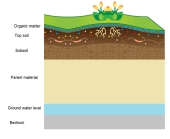












 2
2















John Elliott wrote:Where in So Cal? What's under the sand? If you are in an area that is predominantly creosote bush desert, I'm dubious that these zai would work for you. In order for the zai to work, you can't have several feet of loose sand draining away any moisture. If there is some clay or caliche down a foot or two, well then maybe you have a chance.
You ask how weeds sprout, sometimes the seeds just sit there until they get enough rain, and they can sprout and complete their lifecycle. Such is the case with desert verbena (Abronia villosa) and Sahara mustard (Brassica tournefortii. Those two are very common ground covers on sand dunes, and are adapted to soil moisture draining away quickly.
You may be able to improve the soil quite a bit with biochar. The key benefit of biochar being that it is not going to decompose after a couple of monsoon rains in the hot summer. What is it you want to grow in your patch of sand?
 1
1




Peter Ellis wrote:You might want to look at Fukuoka's seedball planting technique. Plenty of plants manage just fine without humans planting them "1/4 inch deep under fine soil, lightly firmed" or whatever else the seed packet instructions may say

The thing with seedballs is that the seeds get some protection while they wait for favorable conditions.












John Elliott wrote:South Bay has good soil; I thought you were going to say Desert Hot Springs, which a whole different pile of sand. You probably do have clay underneath that sand, close enough that roots can access it. What will really help is to add organic matter to your planting pits, whether you call them zai or hugelkultur or whatever.
Here are some suggestions as to what might grow well:
Artichokes/cardoon -- You are close enough to the coast that they won't have to put up with inland valley heat. They are adapted to Mediterranean climates with dry summers and wet winters. I have even seen them naturalized and growing in Ensenada, which is another level dryer than the South Bay.
Hot peppers -- I mentioned in another thread that these can be grown in planters or espaliered against a building. They are also adapted to drought and dry spells add to the heat of the pepper.
Prickly pear cactus/Nopal -- These will need the least soil prep, just stick them in the ground and water them once a month or so. You can do the same trick with aloe, but I have never found an "edible" variety that I didn't have to spit out.
These are three possibilities that may handle the drought better than other plantings. Under normal circumstances, you can grow almost anything along the coast in SoCal. With the water situation the way it is though, it's probably safer to plan on dry adapted plants, i.e., sorghum might have been a better choice than that water sucking corn.





|
Slime does not pay. Always keep your tiny ad dry.
turnkey permaculture paradise for zero monies
https://permies.com/t/267198/turnkey-permaculture-paradise-monies
|



